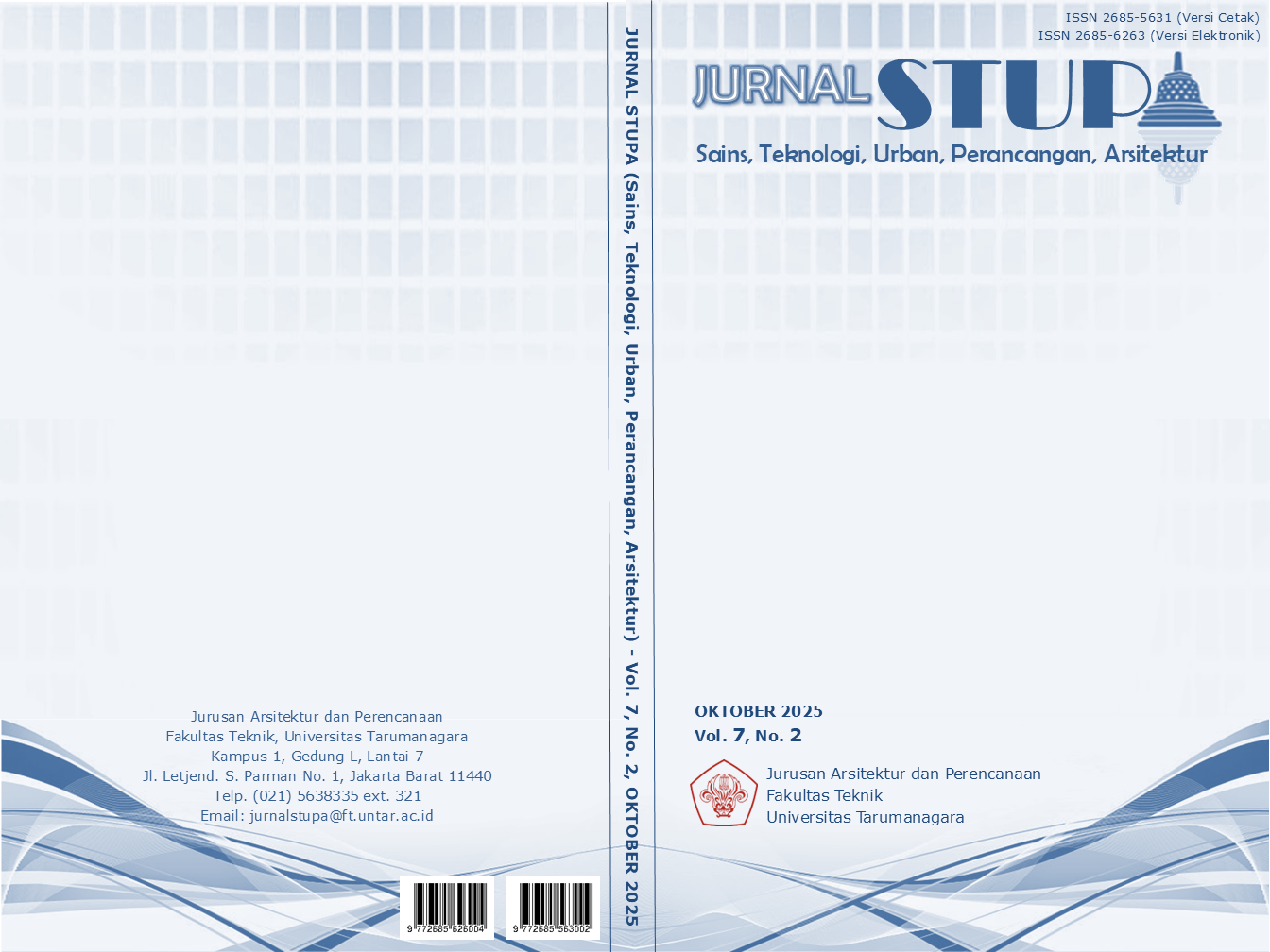INTEGRASI RUANG LITERASI LINGKUNGAN DAN WISATA PERTANIAN MINA PADI SEBAGAI STRATEGI REGENERASI RUANG HIJAU DI PLUIT
Isi Artikel Utama
Abstrak
North Jakarta, a city originally known for its swamps, fish ponds, and green spaces, is experiencing massive development. Along with it, the loss of green space and the increase in groundwater use have been occurring. By 2025, the existing green space in Jakarta has only reached 5.3% of the 30% target set by Law No. 26/2007. 30.4% of Jakartans still rely on groundwater as a water source without understanding the risks of flooding and land subsidence. This research aims to address the needs of public green spaces and environmental literacy through regenerative architecture, envisioning a harmonious integration of urban development and nature. The study was conducted qualitatively through data collection techniques that combined observation and secondary references from journals, map publications, statistics, and books. This process was followed with a precedent study of regenerative systems, rice fish, and similar projects as a basis for biophilic design. The results of this study suggest that rice-fish farming offers a viable path to regenerate green spaces. This green space regeneration strategy was driven by its strong alignment with Pluit's historical context, economic feasibility, and community needs. This initiative also integrates rice-fish-based literacy and tourism, which features a net-positive wastewater treatment system. The combination forms a holistic architectural solution regarding the environmental, social, and economic aspects.
Keywords: biophilic; literacy; regenerative;rice-fish; tourism
Abstrak
Pluit, daerah dataran rendah yang dulunya dipenuhi rawa, tambak ikan, dan ruang hijau kini mengalami pembangunan masif. Seiring dengan itu, terjadi penutupan ruang hijau dan penggunaan air tanah secara ekstrem. Hingga 2025, ruang hijau yang ada di Jakarta baru mencapai 5,3 % dari target 30% yang dicanangkan UU No. 26 Tahun 2007. Sebanyak 30,4% masyarakat Jakarta juga masih mengandalkan air tanah sebagai sumber air tanpa memliki pengetahuan soal risiko tindakannya, yakni banjir dan penurunan muka tanah. Oleh karena itu, penelitian ini bertujuan untuk menyikapi kondisi fisik Pluit dan kesadaran literasi lingkungan dengan arsitektur regeneratif. Dengan begitu, visi pembangunan dan suasana alam yang selaras dapat tergambarkan. Penelitian ini dilakukan secara kualitatif dengan teknik pengumpulan data yang mengombinasikan observasi dan referensi sekunder seperti jurnal, publikasi peta, statistik, dan buku. Proses ini dilanjutkan dengan studi preseden sistem regeneratif, mina padi, dan bangunan sejenis sebagai landasan rancangan yang memanfaatkan pendekatan biofilik. Hasil penelitian ini menunjukan bahwa ruang hijau yang hilang dapat diwujudkan kembali dengan pertanian mina padi. Pemilihan opsi tersebut sebagai bentuk regenerasi ruang hijau disesuaikan dengan sejarah, kebutuhan kawasan Pluit, dan kelayakan secara ekonomi. Hal ini didukung dengan ruang literasi dan wisata berbasis mina padi yang dioperasikan dengan sistem pengolahan limbah air yang bernilai positif. Kombinasi tersebut membentuk solusi arsitektur yang holistik terkait lingkungan, sosial, dan ekonomi.
Rincian Artikel

Artikel ini berlisensiCreative Commons Attribution-NonCommercial-ShareAlike 4.0 International License.
This work is licensed under a Jurnal Sains, Teknologi, Urban, Perancangan, Arsitektur/ STUPA Creative Commons Attribution-NonCommercial-ShareAlike 4.0 International LicenseReferensi
Ahmadian, I., Yustiati, A., dan Andriani, Y. (2021). Produktivitas Budidaya Sistem Mina Padi Untuk Meningkatkan Ketahanan Pangan Di Indonesia: A Review. Jurnal Akuatek, 2(1), 1–6.
Arsip Kompas. (2018). Pluit, Rawa Elite. Kompas. https://www.kompas.id/baca/arsip/2018/10/13/pluit-rawa-elite
Assifa, F. (2021). Ekspolitasi Air Tanah dan Prediksi Jakarta Tenggelam 10 Tahun Lagi. Kompas.Com. https://www.kompas.com/wiken/read/2021/10/09/083358281/ekspolitasi-air-tanah-dan-prediksi-jakarta-tenggelam-10-tahun-lagi?page=all
Baper, S. Y., Khayat, M., dan Hasan, L. (2020). Towards Regenerative Architecture: Material Effectiveness. International Journal of Technology, 11(4), 722–731. https://doi.org/10.14716/ijtech.v11i4.2631
BPS. (2025). Indeks Pembangunan Literasi Masyarakat dan Unsur Penyusunnya Menurut Kabupaten/Kota di Provinsi DKI Jakarta, 2024. https://www.bps.go.id/id/statistics-table/3/VEd0V05FTjBaRVJuYzA1bVkwcHlhVk5KUjJGTlVUMDkjMw==/indeks-pembangunan-literasi-masyarakat-dan-unsur-penyusunnya-menurut-provinsi--2024.html?year=2024
Cahya, M. D., Yustiati, A., dan Andriani, Y. (2021). Sistem Budidaya Polikultur dan Integrated Multi Trophic Aquaculture (IMTA) di Indonesia: Sebuah Ulasan. Journal of Fisheries and Marine Science, 4(2), 72–85.
Hardjanto, K. (2021). Implementasi Budidaya Mina Padi Di Kota Magelang. Chanos, 19(1), 115. https://doi.org/10.15578/chanos.v19i1.9034
Hargrove, J. (2023). What is regenerative design? ARUP. https://www.arup.com/insights/what-is-regenerative-design/
Hickerson, H. T., Lippincott, J. K., dan Crema, L. (2022). Designing Libraries for the 21st Century. the Association of College and Research Libraries. https://www.ala.org/sites/default/files/acrl/content/publications/booksanddigitalresources/digital/9780838936726_OA.pdf
JY. (1995, January). Langkah Antisipatif Raksasa Mall. Properti Indonesia, 29.
Lehmann, S. (2023). Reimaging the Library of the Future. From Social Condenser and Community Hub to Regenerative Design. Public Library Quarterly, 43(2), 223–259. https://www.tandfonline.com/doi/full/10.1080/01616846.2023.2242626#abstract
Merriam Webster. (n.d.-a). Biophilic. Merriam-Webster.Com Dictionary. Retrieved April 18, 2025, from https://www.merriam-webster.com/dictionary/biophilic#nearby-entries
Merriam Webster. (n.d.-b). Library. Merriam-Webster.Com Dictionary. Retrieved November 12, 2024, from https://www.merriam-webster.com/dictionary/library
Michael, F., dan Carina, N. (2024). Revitalisasi Kawasan Harmoni: Penanganan Sudut Simpang Harmoni dengan Karakter Hijau. Sains, Teknologi, Urban, Perancangan, Arsitektur, 6(2), 889–904. https://doi.org/10.24912/stupa.v6i2.30873
Naboni, E., dan Havinga, L. (2019). Regenerative Design in Digital Practice. COST Action RESTORE WG2. https://issuu.com/kadk/docs/regenerative_design_in_digital_practice_lowres
Noorhayati Sutisno, A., dan Hidayat Afendi, A. (2018). Penerapan Konsep Edu-Ekowisata Sebagai Media Pendidikan Karakter Berbasis Lingkungan. Jurnal Ecolab, 12(1), 1–11. https://doi.org/10.20886/jklh.2018.2.1.1-11
Petriella, Y. (2025). Polemik Kenaikan Tarif Air PAM Jaya antara Luas Cakupan dengan Kualitas Layanan. Bisnis Indonesia. https://hijau.bisnis.com/read/20250206/651/1837561/polemik-kenaikan-tarif-air-pam-jaya-antara-luas-cakupan-dengan-kualitas-layanan
Prakoso, P., dan Herdiansyah, H. (2019). Analisis Implementasi 30% Ruang Terbuka Hijau (Analysis of 30% Green Open Space Implementation in DKI Jakarta). Majalah Ilmiah Globe, 21(01-04–2019), 17–26.
Rofiqi, A. (2024). Environmental literacy research trends in education : A systematic literature review. Assimilation: Indonesian Journal Of Biology Education, 7(2), 81–94. https://ejournal.upi.edu/index.php/asimilasi/article/download/69055/pdf
William, B., dan Ryan, C. (2014). 14 Patterns of Biophilic Design. Terrapin Bright Green. https://www.terrapinbrightgreen.com/wp-content/uploads/2014/09/14-Patterns-of-Biophilic-Design-Terrapin-2014p.pdf
World Economic Forum. (2016). New Vision for Education : Fostering Social and Emotional Learning through Technology. In World Economic Forum (Issue March). http://www3.weforum.org/docs/WEF_New_Vision_for_Education.pdf
Yale Center for Environmental Law dan Policy. (2023). 2022 EPI Results. https://epi.yale.edu/epi-results/2022/component/epi
Yanwardhana, E. (2025). Target Besar Gubernur Pramono: Ruang Terbuka Hijau Jakarta di Atas 10%. CNBC Indonesia. https://www.cnbcindonesia.com/news/20250430125936-4-629930/target-besar-gubernur-pramono-ruang-terbuka-hijau-jakarta-di-atas-10
Yildirim, M. S., Elkoca, A., Gökçay, G., Yilmaz, D. A., dan Yıldız, M. (2025). The relationship between environmental literacy, ecological footprint awareness, and environmental behavior in adults. BMC Public Health, 25(1). https://doi.org/10.1186/s12889-025-21340-3
Zhong, W., Schröder, T., dan Bekkering, J. (2022). Biophilic design in architecture and its contributions to health, well-being, and sustainability: A critical review. Frontiers of Architectural Research, 11(1), 114–141. https://doi.org/10.1016/j.foar.2021.07.006



